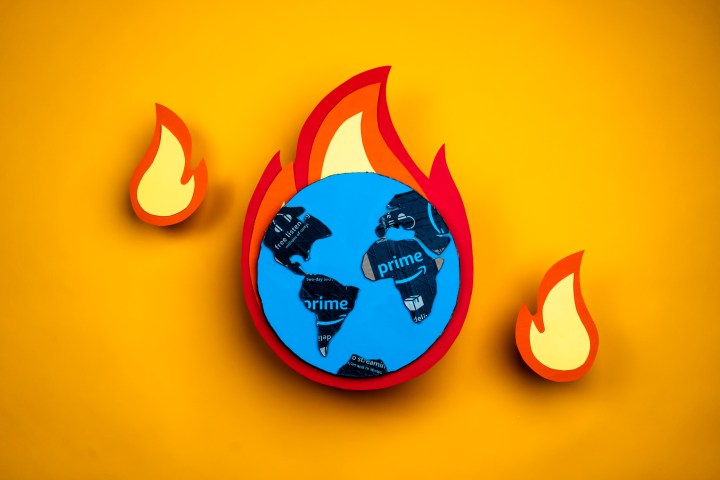
Prime shipping has become a way of life for a lot of people in the U.S. since it launched 15 years ago. On the anniversary of Amazon Prime, which falls on Sunday, it’s hard to imagine a world without free two-day shipping.
But it comes with a cost: Amazon puts out 44.4 million metric tons of carbon every year, about the same as the nations of Norway or Hong Kong, according to the Global Carbon Atlas.
Exactly how the company produces this much carbon is being kept opaque — it wasn’t until last year that Amazon even publicly released these numbers, and the details were scant. “We don’t know how much of that is from data centers or delivery,” said Elizabeth Jardim, senior corporate campaigner for Greenpeace.
Sky-high emissions
Amazon reportedly logged 600 orders per second on Prime Day in 2016. All of those orders, and their ultra-fast delivery methods, generate carbon. To truly hit zero emissions, something Amazon has now pledged to do, would take a technological miracle.
“We would need to have no-emission flights, which is not going to be something that happens in the short term,” Jardim said. “They would have to rearrange or change expectations around how Prime works, and consolidate shipping.”
Consolidated shipping is not Amazon’s forte. A report done by Buzzfeed showed that massive use of Prime shipping, particularly on “holidays” like Prime Day, actually results in less consolidation and more waste generation.

According to Greenpeace, Amazon’s growth has outpaced its renewable energy investment in certain sectors. And at present, Greenpeace said, Amazon’s climate pledge does not cover its supply chain logistics. A major factor in this is its use of airplanes.
“Aircraft is one of the sources of pollution that we have a hard time controlling, and it’s one of the most carbon-intensive ways to ship products.” said Adrian Martinez, a staff attorney for Earthjustice’s Right to Zero campaign. The group recently filed a petition on behalf of a coalition of grassroots groups in Southern California to pause the construction of a new cargo terminal at the San Bernardino airport, which is rumored to be for Amazon.
“We’re hearing there’s a lot of interest in expanding air freight and using air freights to ship products around the country, and that has an immense impact on greenhouse gases and localized health,” Martinez told Digital Trends. “These airplanes and the equipment that it takes to run an airport have immense localized impacts in the communities next to those airports and along the shipping corridors. Their use of shipping is deeply concerning.”
“Planes are a segment they are increasingly relying on as they go for one-day shipping,” said Rebecca Deutsch, a Climate Justice Organizer with the grassroots organization 350 Seattle. “But they haven’t said anything about the amount of pollution produced from that. It’s also the part of the transportation industry that’s the furthest away from being clean. So, ideally, they’d be reducing reliance on air travel, but they seem to be going in the opposite direction.”
Amazon has said it is working to reduce its carbon emissions by air, though details are scarce.
Slowing down shipping
To lower Amazon’s environmental impact, we would all need to get used to waiting a few days for our packages instead of mere hours. “Slowing it down is the right way to go,” Jardim said. “It couldn’t fix everything, but it would be helpful.”
Of course, the onus lies on Amazon to make big structural changes, and not on the individual customers, said Deutsch, especially since one-day and Prime shipping can be a great boon to people with disabilities and chronic illnesses. But making it the path of least resistance for everyone leads to a lot of unnecessary waste, for which Amazon is not taking responsibility, she said.

“I would caution that it needs to be corporations who take full responsibility, and not push the responsibility onto the customers,” she told Digital Trends. “We have to change the system. We can’t change cultural norms until we change the system, and perhaps that includes Amazon not pushing people so much to use the one-day shipping.”
Amazon could also do better at making its customers aware of their own individual carbon footprints. “They could tell Prime customers that they could choose a slower delivery option, and the impact that would have,” Jardim said.
For instance, listing how much carbon output was generated by each delivery option on the Amazon checkout page would be an easy way to do this. “I think if customers were aware that the delivery speed is related to emissions, that would have an impact,” she said.
A hollow pledge
“I think that the capacity for a zero-emissions Amazon exists, or certainly the resources exist — it’s a matter of, is this company willing to do it,” said Mario Vasquez, communications coordinator for a local Teamsters union that has been fighting the expansion of the San Bernardino Airport. “This community is organizing so that this company will devote its riches to cleaning up our air.”
Amazon CEO Jeff Bezos did, in September 2019, come out with a “climate pledge” just a day before a planned worker’s strike: 1,500 Amazon employees walked out on the job to protest the retail giant’s record on sustainability, and more than 8,700 Amazon workers also signed an open letter to Bezos urging more substantial goals. The company has since tried to crack down on Amazon employees speaking out at all to the media, which has caused a backlash.
1/ Hundreds of us decided to stand up to our employer, Amazon. We are scared. But we decided we couldn’t live with ourselves if we let a policy silence us in the face of an issue of such moral gravity like the climate crisis. #AMZNSpeakOut pic.twitter.com/zWIKku4LF6
— Amazon Employees For Climate Justice (@AMZNforClimate) January 27, 2020
Bezos at the time promised the company’s infrastructure would be 100% renewable by 2030 and be at carbon zero by 2040. Amazon has also ordered 100,000 “electric delivery vehicles” from automaker Rivian, which it plans to utilize starting in 2021. Amazon says the van fleet will help save 4 million metric tons of carbon per year. Only 40.4 million to go.
But again, details are scant. For one, it’s unclear what percentage of Amazon’s delivery fleet these electric vehicles will comprise. There are also multiple other types of transport Amazon uses that it hasn’t committed to changing. And the dates are so far in the future, with no real incremental milestones set out, that it’s hard to hold them accountable, said Deutsch. Her group, 350 Seattle, has worked closely with the Amazon employees who were pushing for these changes.

“Whether the company has it in them comes down to the employees,” she said. “We have not seen any evidence that Jeff Bezos himself is making this the top priority. He didn’t do this himself; the employees demanded it, and the economic is system not set up to make corporations think about the full impact of their product and services.”
Jardim, for one, wasn’t much impressed with these goals or what looked like a lack of progress from Amazon on moving forward with them. She pointed to Google’s work on sustainability, and the recently released climate goals that Microsoft published for comparison: Microsoft is pledging to be carbon negative by 2030, 10 years earlier than Amazon.
“Now, after seeing Microsoft’s plan last week, I expect more from Amazon,” she said. “Being a better climate actor is possible, but it would require a lot of work from Amazon.”
Editors' Recommendations
- Amazon now lets you create up to six viewer profiles on Prime Video
- Amazon raises overtime pay for warehouse workers, but holds back one benefit
- Amazon’s Jeff Bezos commits $10 billion to fighting climate change




